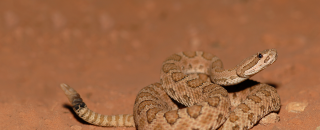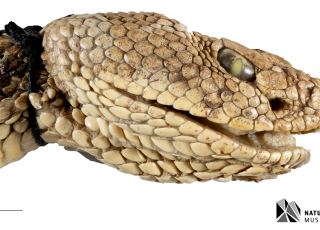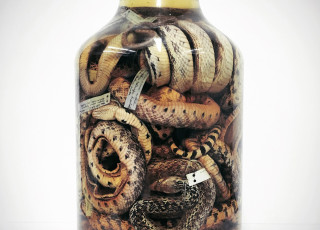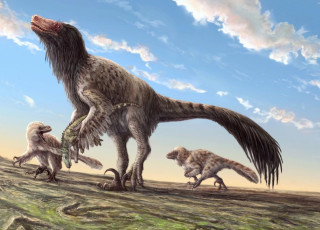The best snake is not a dead snake, but a holotype snake is the best kind of dead snake
This midget faded rattlesnake was photographed in southern Utah, close to Arches National Park. iStock photo.
By Drew Dittmer and Katrina Derieg
Part II in a two part series that makes a case for Utah’s most important snake.
How important can one rattlesnake be?
In Part I, I discussed the difficulty of answering questions related to how many snakes there are regarding both the number of species that can be found in a given area, and determining how many individual snakes might be occurring in a location. I ended the post claiming that in Part II I would make a case for the single most important snake in Utah. Of course, much like the previous post, I want to precede my answer by acknowledging the difficulty in making such a bold claim.
Across the diversity of snake species, there are variable life spans. Some species of snakes can live rather short lives of only a few years, but some species of rattlesnakes can live at least 2-3 decades and maybe longer (Waldron et al 2013). No matter how long a snake lives, herpetologists only get brief glimpses into what a wild snake’s day to day life is like. And to be fair, these brief glimpses are very important! Much snake research uses radio telemetry, wherein a small transmitter is implanted inside of a snake’s body cavity enabling a researcher to locate the snake with a radio receiver. Radio telemetry studies have helped reveal the amount and kinds of habitats that different snake species prefer. Mark and recapture studies are another method used to address questions related to habitat preferences, home range sizes, and even population sizes. Some studies of wild snakes even go as far to encourage snakes to regurgitate their most recent meals to identify and quantify the prey species that some snakes focus their hunting efforts on. All that being said, the overwhelming majority of snakes will live out their lives and never reveal their secrets to herpetologists. Even those snakes that do end up being studied by biologists will only yield a small fraction of their lives to the resulting data sets.
There is a common saying that “the best snake is a dead snake”. While I firmly disagree with the implied sentiment that snakes are hated creatures, dead snakes can and do contribute to research grade information for decades, even centuries! I am tempted to say “a dead snake is forever”, but that’s a stretch. Regardless, herpetologists have been studying, analyzing, and learning from dead snakes for centuries. To this day dead snakes play an important —albeit unappreciated— role in adding to the body of knowledge about their natural history. While pirates have famously said that dead men tell no tales, many herpetologists could say that dead snakes can answer questions. One of the most important questions being, what species of snake is this?
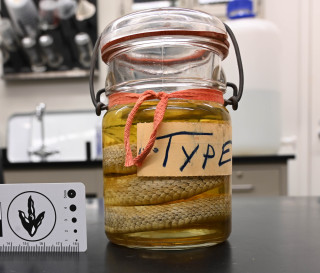
New species of snakes are often described and even discovered from the deceased and preserved specimens maintained in natural history collections. Natural history collections typically hold specimens that are decades and sometimes even centuries old. This record of specimens is somewhat like a library, and it is possible to “read” the specimens to investigate and update our knowledge about them. In 2021 researchers published a paper in which they used 185 year old paintings of snakes from India and 100+ year old specimens to determine what was previously thought to be one species, is actually two species (Deepak et al 2021).
It is important to note that not every dead snake is important or capable of answering interesting questions. To achieve their highest potential, dead snakes need to be paired with the following:
- They must be carefully preserved as specimens. This can be achieved with preservatives such as formalin and ethyl alcohol, cleaning the meat off the bones and saving skeletal material, or simply taking a sample of tissue (e.g. muscle, liver, skin) and freezing it to be used for genetics or disease research. A specimen may even be preserved using more than one of these techniques to get the most out of a single specimen.
- Important data/information should be preserved with the specimen. At a minimum,where the specimen was found, and when the specimen was collected should be documented. Ideally, the collector would also record observations about the animal’s habitat, and characteristics of the animal such as color, measurements, or sex.
- The specimens should be maintained in a natural history collection or museum that allows scientists to examine the specimens
- The natural history collection or museum should maintain a digital catalog that cross references any additional data that are associated with the specimen.
These components are the fundamentals of the “Extended Specimen Concept”, which is the practice of not only preserving and maintaining specimens, but connecting each specimen to the most amount of information as possible. Each part of the specimen (e.g. tissues, eggs) and all of its data (e.g. locality, physical features) are extensions of the specimen itself and connecting all of these components to the original specimen unlocks its potential for research. In recent decades, museums have put forth tremendous effort to use digital technology to extend specimens. This has been an expansion of the original purpose of natural history collections which is to document, describe, and name new species using specimens.
To provide a name for a new species, it is critical to have a reference point for that name. How does a species get a name? Broadly speaking, biologists use type specimens to aid them in determining which names belong to specific species. But what exactly is a type specimen, and how is a type specimen designated? The answer to this question is arguably one of the most important and fundamental roles filled by natural history museums. Natural history museums are the caretakers and stewards of preserved remains of animals and plants, and some of these preserved remains can be type specimens. Additionally, and perhaps pedantically, it should be noted that there are different categories of type specimens. To keep it simple, in this scenario we will focus on the specimen category known as a holotype, which is a single specimen that is used as a reference when a species is first described to the scientific community.
Context is critical when making an argument for something as important as Utah’s most important snake. Hopefully at this point most readers have guessed that the snake is dead, and is a holotype specimen, but to finally reveal the identity, the snake is cataloged specimen UMNH 306, Crotalus oreganus concolor, Midget Faded Rattlesnake. This specimen is the holoypte specimen for the species. It was collected in September of 1929 by Angus M. Woodbury, who was the first curator of the University of Utah Museum of Zoology, which is now part of NHMU’s Vertebrate Zoology collections. Until recently this specimen was believed to be lost! Recently the Vertebrate Collections Manager, a Philosophy Graduate Student/Snake enthuisiast, and the UDWR’s herpetologist managed to relocate the lost specimen within the collection. Additionally, this small team was able to locate digital archives of Angus Woodbury’s original description of the specimen. This original description is now hyperlinked/cross referenced to the specimen record on Arctos.
The case for the holotype specimen being Utah’s most important snake is supported by at least two arguments. First the holotype specimen was collected in Utah, by a Utah resident, herpetologist, and former curator of the NHMU’s vertebrate collection. Second, the bulk of the distribution of the Midget Faded Rattlesnake is within the state boundaries of Utah. Notably the distribution also includes parts of Wyoming, Colorado, and possibly a smidge of Arizona. Broadly speaking the Midget Faded Rattlesnake is the only rattlesnake that reliably occurs across the Colorado Plateau portions of Utah. Therefore, and in consideration of all of this information, the Midget Faded Rattlesnake is by most measures Utah’s rattlesnake, and the holotype specimen that anchors the species name (Crotalus oreganus concolor) is the most important single snake that aids in giving this rattlesnake its name and species description.
Waldron, J. L., Welch, S. M., Bennett, S. H., Kalinowsky, W. G., & Mousseau, T. A. (2013). Life history constraints contribute to the vulnerability of a declining North American rattlesnake. Biological Conservation, 159, 530-538.
Read Part One in this series "A nomination for Utah’s Most Important Snake"
Dr. Drew Dittmer is a herpetologist and a native species coordinator for the Utah Division of Wildlife Resources. Katrina Derieg, formerly the vertebrate collections manager at the Natural History Museum of Utah, is now a curator at the University of Montana. NHMU is a part of the University of Utah in Salt Lake City. Our mission is to illuminate the natural world and the place of humans within it. In addition to housing outstanding exhibits for the public, NHMU is a research museum. Learn more.
